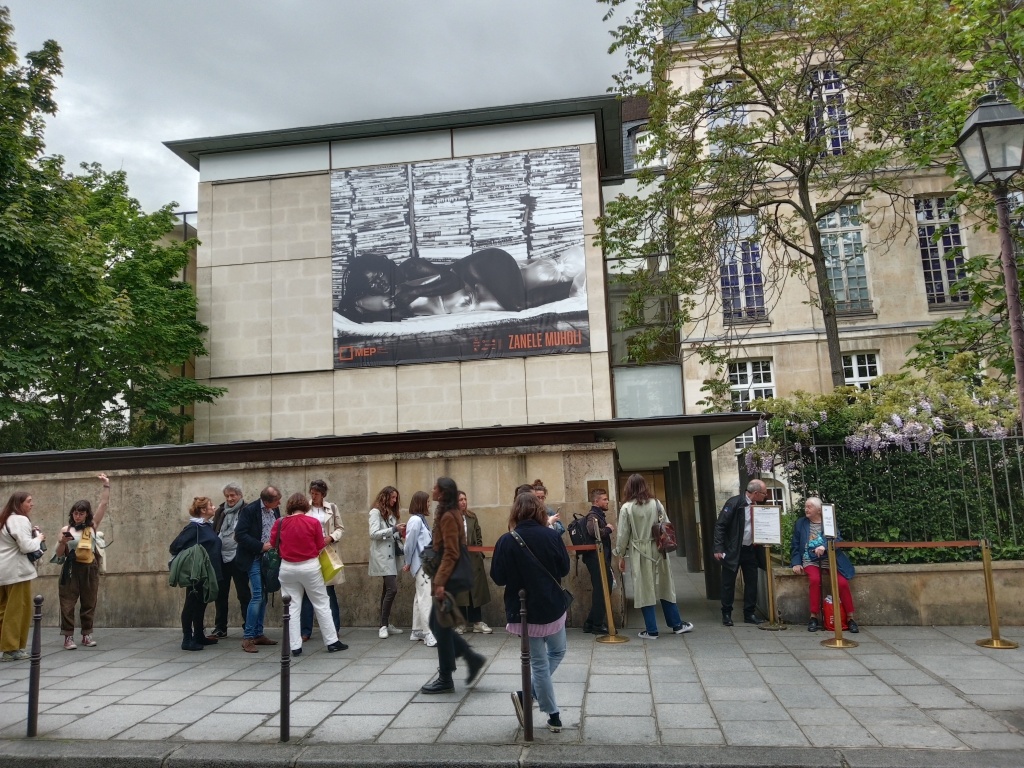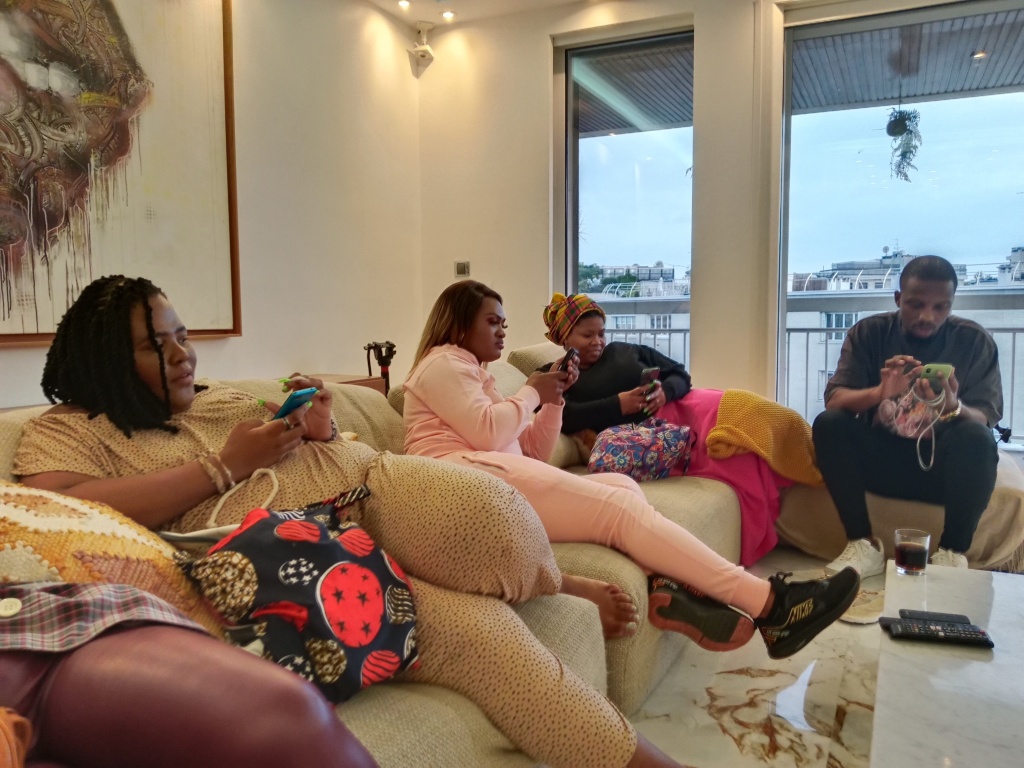by Fikile Mazambani
“It is beyond this work being about photography. It is about people connecting with people. It is about people respecting people”- Z Muholi
Zanele Muholi’s exhibition at the Maison Européenne De La Photographie (MEP) concluded on the 21st of May, 2023 in Paris after a successful three month run. An astonishing 80 000 people viewed their first retrospective dedicated to them in France. It boasted over 200 images set on all three floors of the entire building, spanning two decades of their work documenting members of the black LGBTQAI+ communities in South Africa and beyond.

They attributed the show’s success to preparation and the right time in their career coinciding. It happened at a time where Muholi had documented enough works to fight ignorance and Paris was the perfect stage for the retrospective. Paris known as the city of love, is also the city where art lovers converge. Their love for art and belief in cultures and heritage nurtures many open-minded people and even then, the work is never done.
‘This was the first black queer exhibition ever and it was BIG!’ exclaims Muholi who was both introspective and pleased. They take in this milestone moment and muse about the day where there will be another black artist – who is perhaps yet to be born – who will use the show as a future reference as it will become a historical reference that will be recorded by art historians and be read in visual art histories. It would be used as a precedent to note one who had the ability to have 80 000 museum visitors in just a short space of time whereas these kinds of numbers take about a year or more to accumulate, depending on the length of stay granted to the artist to show. The exhibition has already been requested to show in another European country in 2025. Although not effusively exuberant in their expression, you can deduct they are proud of the work they have produced over the years. They say this is the beginning of the real work.

The work serves as an interventionist tool for different peoples as evidenced by the diverse audiences that showed up at the MEP. Muholi became impassioned when emphasising why the show was a success. To them, it was clear because for starters queer people were born by people who might not be queer and may have curiosities and questions. Parents, family, friends, colleagues, acquittances etc., may want to understand or seek to validate their loved ones. Lerato Dumse, Faces and Phases participant, said of the show, these are the materials they needed at 14 when trying to make sense of the world. ‘Now children do not need to be given a two-page brochure at the clinic branded “safe sex”.’ It did nothing for a questioning child who just wondered if there were similar people who felt differently, just like them. Nothing to do with copulation.
Attendees came from all walks of life and they could have been professionals and scholars looking to better understand populations they work with and want to serve them holistically. They could have been writers looking to tell stories that needed telling, while others could be seeking collaborations, conversations, clients or to see themselves in the portraits. The possibilities endless. Muholi believes that once their work is out there it is beyond the community and takes on the role of service provision beyond being just an image on the wall or book. It becomes about people connecting with people, about people respecting people and people being open minded and asking questions instead of harbouring ignorance, angst and hate.
They have best practices that they believe in and incorporate into their work. Collaborations are a big thing for them as they believe artists should support other artists and individuals that they work with. For this exhibition they collaborated with Annalyzer (Anelisa Stuurmman) a powerful vocalist, musician and imbongi (praise poet) and Llewelyn Mnguni, a ballet, African & contemporary dancer and choreographer, who used song and dance to elevate the story telling. The lithe Mnguni had collaborated with Muholi before in 2017 for a Somnyama Ngonyama installation. “I choreographed a piece connected to the artwork and brought them to life in movement artform.” They are also involved with activism work focusing on queer youths and the area of suicide. “I see it as talking about my life.”
Participants were invited by the photographer because their presence ‘enriches the show’. It was an emotional journey for the participants. Bathini Dambuza, a writer and hairdresser was already emotional at seeing herself on the walls of the French museum but was even more moved because ‘as soon as I walked into the Faces and Phases exhibition, I saw people I knew who had transitioned to the next life and that overwhelmed me”. Reliving moments while taking in the gravity of being recorded in history as having existed. Charmain Carrol, a photographer and community centre owner said she reacted to seeing her picture in a way that caught other spectators’ attention. “On realisation that I was the same person, as the portrait on the wall, I got a lot of questions and I answered all of them. I was there to tell my story, to speak my truth”. How many people could say they had the privilege of such a moment in time?

As an art practitioner who takes photographs to create a visual history of the LGBTQAI+ community Muholi asserts that it is important to bring forth those who make this work possible as they have already become content producers by working alongside the photographer. They believe the participants are the art historians/anthropologists whose visual narratives create works of history. ‘I know that it would not even have been possible to be invited to exhibit in this space where it not for those featuring in the show’. They invited nine participants from South Africa and one from France to be part of the show. Four collaborators and staff were also at hand.
“The show left me broke because I had to cover air tickets, cover food, board and transportation – which are all super expensive in Paris.” The money could have gone into the pockets of the participants instead of them travelling but it is their long-held wish for participants to see how the other side of the world receives and celebrates them and their contribution. Because some of the participants are late, Muholi would like start inviting next of kin who are of age to travel and witness their loved one’s contributions. They are also thinking around establishing a scholarship as another best practices point. Muholi would not pretend all this self-funded work was steep, it was expensive but it did not deter them from doing what they feel is the right thing. Even though this show was not for sale, it is a strong desire of theirs that earnings from art sale proceeds should be split, firstly with the person being photographed and then with the museum or gallery. This may not be the norm in the art world or even mentioned in art books but it is something they feel needs to be a conversation.
Most people mentioned Muholi’s generosity which could be attributed to who they were raised to be as a person. The spirit of Ubuntu, of never forgetting where you come from and whose shoulders you stand on. Dumse who also works with Muholi as a coordinator has also gained something that money cannot buy. “Working with Muholi has taught me a lot, e.g. how to handle relationships, read situations, work ethic and ethics as a human being. They try to teach love. It was their love for the community that led them to say I want to see us shown beautifully”.
Dambuza who says she was invited to document and see the bigger world echoes those words and adds that “Muholi gets frustrated when stuff is not done and working with them puts you in a bit of pressure because you understand it is not always about pleasure”. She laughs as she recalls a rebuke about watching those who have already made it while not doing the same. “I really appreciate that about them because things make sense when I am with them.”
Carrol feels more at speed with Muholi’s pace. As a transplant from the metropolitan Johannesburg to the resources deprived rural areas, she understands the constant uncertainty of everyday and working to normalise it. “Working with Muholi has been a rollercoaster ride because Muholi’s mind moves fast and you have to keep up with the pace and not get lost in everything. You always have to be on your toes and I love it so much.”
As Kim Nam Jun, avid art enthusiast/collector, lyrical philosopher and leader of mega group BTS raps in Yun, “I wanna be human before I do some art”, quoting his favourite artist Yun Hyong-keun. He states that before the art is the person, their ideals, philosophies and narratives they wish to convey. The question then becomes, who is this person? Who is Zanele Muholi? I would say Zanele is an established art insider who guards their humanity first because that is the well they tap into and create from. It allows them to show their best authentic self and therefore work. They nurture relationships that nurture their creativity. It is clear to see why the 2023 MEPS Retrospective was a resounding success. Watching Muholi in action was no only an opportunity to see them work but also walk the talk. They stand on their values. That in its own, was an experience.
